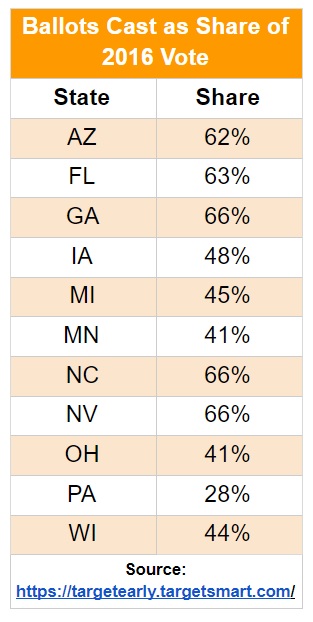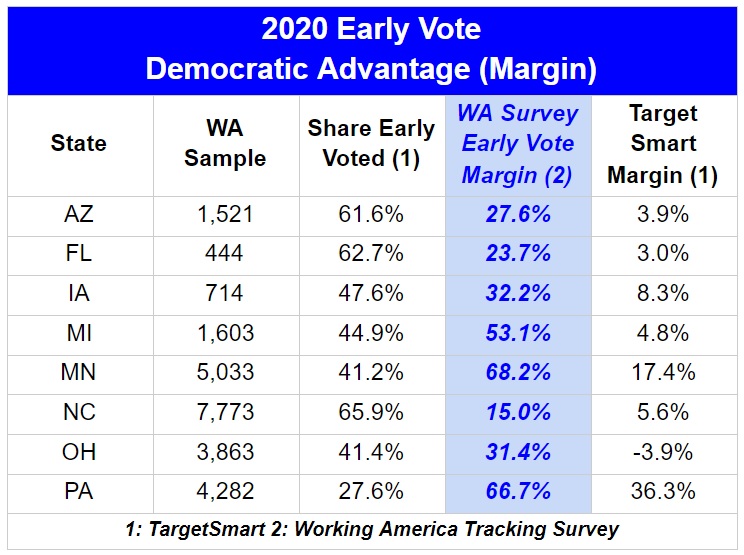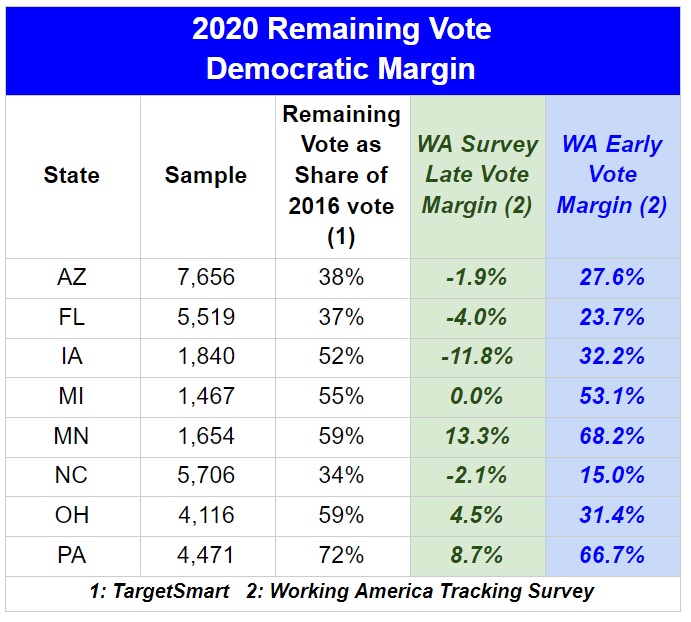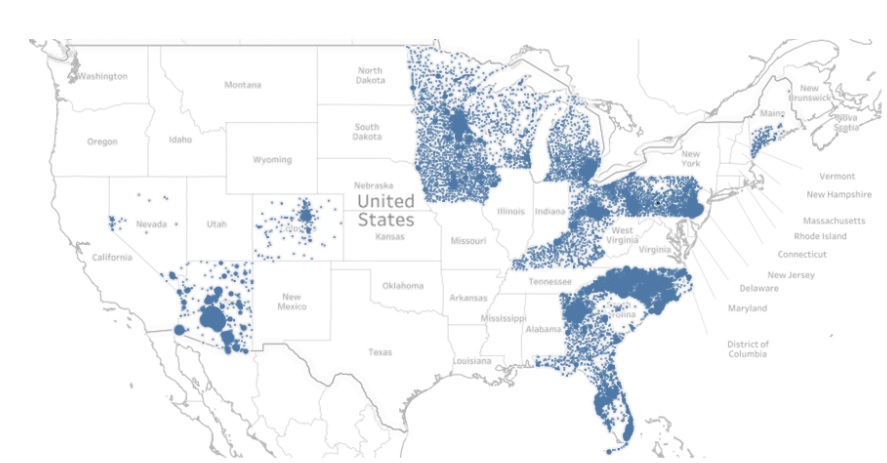The following article by Ruy Teixeira, author of The Optimistic Leftist and other works of political analysis, is cross-posted from his blog:
David Shor on the 2020 Election
Perhaps you’ve heard of Shor, if for no other reason than he got purged from the Civiqs research firm for wrongthink–daring to tweet, based on academic research, that violent protests tend to produce less positive change than peaceful protests.
But Shor is also one of sharpest data science people around and obsessively dedicated to helping Democrats get elected and pass progressive legislation. He has very high level technical skills, intimate acquaintance with a wide range of data and deep understanding of the relevant political science research. Refreshingly, he takes his analysis in whatever direction the data indicate and is entirely willing to discard the conventional wisdom where appropriate. He is very definitely not trying to be politically correct.
So this long interview with Shor on Politico is very much worth reading. I don’t agree with everything here but I take it all very seriously. I urge you to do so as well. Some particularly cogent excerpts–
On the vexed influence of college educated white liberals on the Democrats:
“[A]s college-educated white people enter the Democratic Party and become an increasingly large share of the Democratic Party while the reverse happens to Republicans, that naturally is going to influence who wins party primaries and what kind of people win internal party fights. In practice — given the fact that college-educated whites donate at disproportionate rates and volunteer at disproportionate rates — I think it’s going to be very hard for Democrats to resist the pull of catering to their preferences, which is naturally going to lead to losing votes among people who aren’t them: not just non-college educated whites, but, as we as we saw this cycle, also non-white voters.
It’s a reasonable expectation that these gaps will continue to grow unless parties make a concerted effort to swim upstream. And even then, it’s probably going to be more about slowing things down or keeping things where they were. I think an underappreciated aspect of Barack Obama is that he actually presided over one of the only periods of educational depolarization. In 2008 and 2012, the education gap actually depolarized, because he did unusually well among non-college whites in the Midwest. And some of that is probably the recession. So, it’s not impossible, but it will be hard.”
On the decline of ticket-splitting and the implications for Democrats in swing districts:
“In 2020, there was this idea that ticket-splitting was going to increase, but actually, there was considerably less ticket-splitting than we were expecting. Democrats really expected our Senate candidates to overperform Biden. That didn’t happen at the rates the public polls suggested they would. There’s a pretty similar story you can tell about the U.S. House. This decline in ticket-splitting means that when people are voting on their local House candidate, they’re increasingly doing that on the basis of the news they read about the national Democratic Party. And this creates a hard tradeoff: It’s no longer true, in a way that might have been true 20 or 30 years ago, that someone in a safe seat can say whatever they want to energize the base without creating consequences in swing districts. Now, that doesn’t mean that Abigail Spanberger, for instance, should control the exact contents of what gets said, but it really highlights the importance of being disciplined and embracing things that are popular and not embracing things that are unpopular. I think that AOC has proposed a lot of things that are incredibly popular. The Loan Shark Prevention Act, which caps credit card interest rates at 15 percent — in the New Progressive Agenda Project polling we did with Sean [McElwee], where we have pro and con arguments, this was one of the most popular policies we ever tested.
But now that we have this increased polarization, we can’t escape that. There are very real tradeoffs to talking about things that aren’t popular. Obviously, there’s a lot of disagreement about what is popular and what isn’t, and polling is hard. It’s very easy to create polls that make single-payer health care popular or background checks [for gun purchases] popular. But then when these things show up at the ballot box in various ways, they end up losing. The things that liberals want — or that the left wants — some of them are very popular and some aren’t, and I think we have to be honest with ourselves about which is which. And that can be difficult, both from a coalition perspective and emotionally, but the importance of it is very high.”
On the utility of “anti-racist deep canvassing”:
“The important thing to remember about campaigns, big picture, is this: The average voter in a general election is something like 50 years old — in a midterm or primary, it’s higher. They don’t have a college degree. They watch about six hours of TV a day — that’s the average; there are people who watch more. They generally don’t read partisan media. They still largely get their news from mainstream sources. They’re watching what’s on the ABC Nightly News. Maybe they see some stuff on Facebook, but it’s really mostly from mainstream sources.
You have to center on this person, and think about how they’re interacting with politics. With all of these things, whether canvassing or digital ads, the reality is that people are mostly forming their opinions on the basis of what the press says….In 2016, we didn’t lose because our get-out-the-vote lists were not sorted well enough. And it wasn’t that we had the wrong kind of digital targeting. We lost because, big picture, we ran a campaign that increased the salience of immigration at a time when marginal voters in swing states in the Midwest disagreed with us on immigration. That’s why we lost. Obviously, it was a close election, and maybe you could have done something different and gotten 0.4 points more in Wisconsin. But big picture, that is what happened.”
On defund the police:
“When you look at “defund the police” specifically, there was a real movement among educated, liberal people in the media and among activists across a broad swath of the left to elevate this issue and get folks to talk about it. And there are pros and cons to doing that. I’m not going to claim that I know what the right thing to do is — sometimes, it makes sense to talk about unpopular issues. But we should acknowledge that in practice, those decisions to elevate the salience of certain issues and reduce it on other issues — those decisions are actually something campaigns and activists have a lot of control over. And they are going to end up influencing vote share much more than any decision that any individual campaign makes about what digital vendors they use, or how many digital ads they use versus what TV ads they use.
Ultimately, in this hyperpolarized world, what national media outlets choose to talk about is going to be much more important in determining whether [Democratic Congressman] Collin Peterson survives in Minnesota’s 7th district than anything he does. That’s just the reality. [This month, Peterson lost his bid for reelection.]”
On why Georgia went blue (it wasn’t black turnout):
“The real story behind Georgia, much more than demographic inflow, is just these enormous swings in the Atlanta suburbs, which make up most of the state. There are a bunch of precincts where Obama got 30 percent of the vote, where now Trump got 30 percent of the vote — absolutely wild swings in these highly educated suburbs. That’s most of the story.
In both 2018 and 2020, you see the Black share of the electorate dropping or staying steady, and the support for Democrats among Black and non-white voters in general also dropping, but then support among college-educated white people and turnout among college-educated white people being off the charts. And that is the story: We had already bottomed out among non-college educated whites, and had a lot of room to grow among college-educated whites.”
On the Democrats’ drop in Hispanic support:
“There was an initial tendency to say, “Oh, of course we lost Cubans in Florida,” or “In the Rio Grande Valley, they’re all very conservative.” But within Texas, we also fell tremendously in Hispanic precincts in Houston; there were substantial drops in Hispanic support for Democrats in the northeast, around Massachusetts; same thing in Osceola County, Florida, which is predominantly Puerto Ricans who live near Orlando. In large swaths of the country, there was a pretty broad-based decline. Looking at precincts in Miami-Dade specifically, the decline was basically the same for Cuban precincts and non-Cuban precincts — it was a little bit larger in Cuban precincts, but not by very much.
What’s really interesting is that this change was reflected down-ballot. That’s actually very surprising. In 2016, there were a lot of areas that swung 20 points against Democrats — rural, white working-class areas — but still voted for Democratic Senate, House and state legislative candidates. This year, in a lot of Hispanic areas, down-ballot Democrats got slaughtered. In Florida, we lost Hispanic House seats, and on the state-legislative level, it was pretty brutal. There was a congressional seat in the Rio Grande Valley [Texas’ 15th district] that we had won by 20 points in 2018 and 2016, and this time only won by 3 points. It’s possible that politics is just different now in 2020 than in 2016, but that really tells me that this was a change in party ID more than anything specifically that Trump or Biden did.
There is a broader trend, though, that as college-educated white people become a larger share of the Democratic coalition and a larger share of the Democratic voice, they do pull the party on cultural issues. Non-college educated white people have more culturally in common with working-class Black and working-class Hispanic voters. So, it should be unsurprising that as the cultural power of college-educated white people increases in the Democratic Party, non-white voters will move against us.”
On the coalition the Democrats need:
“We need to change the nature of our coalition if we want to wield legislative power. It’s possible that maybe the Republican Party will just really mess up. But we just had basically the most unpopular Republican president since Nixon, and Democrats were not able to capture the kind of legislative majorities we need to affect change. That highlights the need for us to try to change the nature of our coalition.
That’s not saying anything new to anyone who works in Democratic politics. Everyone from Bernie Sanders to Chuck Schumer to Nancy Pelosi — they would all love to have more working-class white votes. It’s a big question of how you actually do that, but if we care about enacting legislative majorities, the alternatives to us making these changes are bleak.”
On the relative importance of turnout:
“In general, I think people really overestimate the importance of turnout in high-turnout elections. It’s definitely true that turnout was higher in 2020 than in 2016. But it’s clear, looking at the county results, that for the most part, these new voters were Democrats and Republicans in roughly equal numbers.
The story for this turnout increase is less about the mobilization efforts of either Democrats or Republicans; it’s that interest in politics increased in general. You saw this when you polled people and asked how closely they’re following things — it was much higher than four years ago. We’ve had a four-year period where everyone has been very intensely interested in politics. And we’ve never really seen that kind of permanent mobilization before. It’s led to record fundraising numbers, and a record number of protests, and more people running for office, and politics has become higher-status….
I still think mobilization in general is good for Democrats, but it’s a much less clear trade than it used to be, and in whiter parts of the country, it really might not be true at all. In terms of the partisan implications, I expect the effects to be small. The reality is that most of the change from election to election is people changing their minds, not who voted.”
Food for thought. For many thoughts.


 Next, we looked at how the race breaks among early voters. One of the important distinctions between our data and some of the voter-file-based reports is that we see the Biden margin increasing more than partisan identity would suggest virtually everywhere. The difference is that we are reflecting what voters shared with us, while other reports simply use the probable vote choice based on voter file data.
Next, we looked at how the race breaks among early voters. One of the important distinctions between our data and some of the voter-file-based reports is that we see the Biden margin increasing more than partisan identity would suggest virtually everywhere. The difference is that we are reflecting what voters shared with us, while other reports simply use the probable vote choice based on voter file data.



